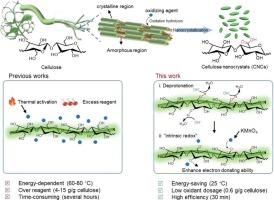Alkali-induced “intrinsic redox” system for room-temperature synthesis of carboxylic acid-functionalized cellulose nanocrystals
IF 12.5
1区 化学
Q1 CHEMISTRY, APPLIED
引用次数: 0
Abstract
The synthesis of carboxylic acid-functionalized cellulose nanocrystals (CNCs) is frequently constrained by high energy consumption, excessive oxidant usage, and stringent reaction conditions. In this work, we propose an “intrinsic redox” system utilizing alkali-enhanced electron-donating capacity of cellulose to overcome these challenges. By deprotonating its hydroxy groups (pKa ~13), cellulose's electron-donating ability is enhanced, allowing it to serve as both the raw material and a reducing agent for the synthesis of CNCs. Mechanistic studies indicate that alkali-induced deprotonation significantly enhances the electron density of hydroxy groups on the surface of cellulose, resulting in a 579 % increase in the nucleophilicity index. This system facilitates CNC extraction at room temperature within 30 min, with a low oxidant-to-cellulose mass ratio (0.6 g/g) and a high yield of 73.05 ± 1.06 wt%. The resulting CNCs exhibit uniform dimensions (206.2 ± 38.5 nm in length, 11.0 ± 2.1 nm in diameter), high crystallinity (72.2 %), and colloidal stability (ζ = −38.8 mV). With 89.5 % closed-loop reagent recovery and value-added byproduct utilization, our methodology offers an industrially scalable platform for green production of nanocellulose.

碱诱导的“内在氧化还原”体系用于室温合成羧酸功能化纤维素纳米晶体
羧酸功能化纤维素纳米晶体(CNCs)的合成经常受到高能耗、过量氧化剂使用和严格的反应条件的限制。在这项工作中,我们提出了一种“内在氧化还原”系统,利用碱增强的纤维素给电子能力来克服这些挑战。通过去质子化其羟基(pKa ~13),纤维素的供电子能力增强,使其既可以作为原料,也可以作为合成cnc的还原剂。机理研究表明,碱诱导的去质子化作用显著提高了纤维素表面羟基的电子密度,使其亲核指数提高了579%。该系统易于在室温下30分钟内进行CNC提取,氧化剂与纤维素的质量比低(0.6 g/g),产率高达73.05±1.06 wt%。所得的cnc具有均匀的尺寸(长度为206.2±38.5 nm,直径为11.0±2.1 nm),高结晶度(72.2%)和胶体稳定性(ζ =−38.8 mV)。我们的方法具有89.5%的闭环试剂回收率和增值副产品利用率,为纳米纤维素的绿色生产提供了一个工业上可扩展的平台。
本文章由计算机程序翻译,如有差异,请以英文原文为准。
求助全文
约1分钟内获得全文
求助全文
来源期刊

Carbohydrate Polymers
化学-高分子科学
CiteScore
22.40
自引率
8.00%
发文量
1286
审稿时长
47 days
期刊介绍:
Carbohydrate Polymers stands as a prominent journal in the glycoscience field, dedicated to exploring and harnessing the potential of polysaccharides with applications spanning bioenergy, bioplastics, biomaterials, biorefining, chemistry, drug delivery, food, health, nanotechnology, packaging, paper, pharmaceuticals, medicine, oil recovery, textiles, tissue engineering, wood, and various aspects of glycoscience.
The journal emphasizes the central role of well-characterized carbohydrate polymers, highlighting their significance as the primary focus rather than a peripheral topic. Each paper must prominently feature at least one named carbohydrate polymer, evident in both citation and title, with a commitment to innovative research that advances scientific knowledge.
 求助内容:
求助内容: 应助结果提醒方式:
应助结果提醒方式:


